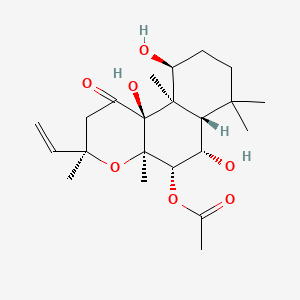| MeSH term | MeSH ID | Detail |
|---|---|---|
| Adenocarcinoma | D000230 | 166 associated lipids |
| Adrenal Cortex Neoplasms | D000306 | 4 associated lipids |
| Albinism | D000417 | 3 associated lipids |
| Alcoholism | D000437 | 27 associated lipids |
| Alzheimer Disease | D000544 | 76 associated lipids |
| Anemia | D000740 | 21 associated lipids |
| Anemia, Sickle Cell | D000755 | 34 associated lipids |
| Angina Pectoris | D000787 | 27 associated lipids |
| Arrhythmias, Cardiac | D001145 | 42 associated lipids |
| Arteriosclerosis | D001161 | 86 associated lipids |
forskolin
Forskolin is a lipid of Prenol Lipids (PR) class. Forskolin is associated with abnormalities such as Cholestasis, Vocal cord dysfunction familial, Hypothyroidism, Renal tubular disorder and Disintegration (morphologic abnormality). The involved functions are known as Cell Proliferation, Anabolism, mRNA Expression, Agent and Signal. Forskolin often locates in Extracellular, Body tissue, Skin, Tissue membrane and Membrane. The associated genes with forskolin are P4HTM gene, SLC33A1 gene, NR1I2 gene, Genes, Reporter and CYP3A gene. The related lipids are Steroids, steroid sulfate, Fatty Acids, LYSO-PC and Lipopolysaccharides.
Cross Reference
Introduction
To understand associated biological information of forskolin, we collected biological information of abnormalities, associated pathways, cellular/molecular locations, biological functions, related genes/proteins, lipids and common seen animal/experimental models with organized paragraphs from literatures.
What diseases are associated with forskolin?
forskolin is suspected in Cyst, Kozlowski Celermajer Tink syndrome, Vocal cord dysfunction familial, Alzheimer's Disease, Cholestasis, Renal tubular disorder and other diseases in descending order of the highest number of associated sentences.
Related references are mostly published in these journals:
| Disease | Cross reference | Weighted score | Related literature |
|---|
Possible diseases from mapped MeSH terms on references
We collected disease MeSH terms mapped to the references associated with forskolin
PubChem Associated disorders and diseases
What pathways are associated with forskolin
Lipid pathways are not clear in current pathway databases. We organized associated pathways with forskolin through full-text articles, including metabolic pathways or pathways of biological mechanisms.
Related references are published most in these journals:
| Pathway name | Related literatures |
|---|
PubChem Biomolecular Interactions and Pathways
Link to PubChem Biomolecular Interactions and PathwaysWhat cellular locations are associated with forskolin?
Visualization in cellular structure
Associated locations are in red color. Not associated locations are in black.
Related references are published most in these journals:
| Location | Cross reference | Weighted score | Related literatures |
|---|
What functions are associated with forskolin?
Related references are published most in these journals:
| Function | Cross reference | Weighted score | Related literatures |
|---|
What lipids are associated with forskolin?
Related references are published most in these journals:
| Lipid concept | Cross reference | Weighted score | Related literatures |
|---|
What genes are associated with forskolin?
Related references are published most in these journals:
| Gene | Cross reference | Weighted score | Related literatures |
|---|
What common seen animal models are associated with forskolin?
There are no associated biomedical information in the current reference collection.
NCBI Entrez Crosslinks
All references with forskolin
Download all related citations| Authors | Title | Published | Journal | PubMed Link |
|---|---|---|---|---|
| Paldino E et al. | Induction of dopaminergic neurons from human Wharton's jelly mesenchymal stem cell by forskolin. | 2014 | J. Cell. Physiol. | pmid:23893793 |
| Rojas-Charry L et al. | Downregulation of Pink1 influences mitochondrial fusion-fission machinery and sensitizes to neurotoxins in dopaminergic cells. | 2014 | Neurotoxicology | pmid:24792327 |
| Cristóbal I et al. | Hyperphosphorylation of PP2A in colorectal cancer and the potential therapeutic value showed by its forskolin-induced dephosphorylation and activation. | 2014 | Biochim. Biophys. Acta | pmid:24997451 |
| Boinot C et al. | Searching for combinations of small-molecule correctors to restore f508del-cystic fibrosis transmembrane conductance regulator function and processing. | 2014 | J. Pharmacol. Exp. Ther. | pmid:24970923 |
| Nwachukwu JC et al. | Resveratrol modulates the inflammatory response via an estrogen receptor-signal integration network. | 2014 | Elife | pmid:24771768 |
| Mardones P et al. | Cyclic AMP and alkaline pH downregulate carbonic anhydrase 2 in mouse fibroblasts. | 2014 | Biochim. Biophys. Acta | pmid:24361611 |
| Aflaki M et al. | Exchange protein directly activated by cAMP mediates slow delayed-rectifier current remodeling by sustained β-adrenergic activation in guinea pig hearts. | 2014 | Circ. Res. | pmid:24508724 |
| DiRaddo JO et al. | A real-time method for measuring cAMP production modulated by Gαi/o-coupled metabotropic glutamate receptors. | 2014 | J. Pharmacol. Exp. Ther. | pmid:24659805 |
| Luckie DB et al. | Chemical rescue of ΔF508-CFTR in C127 epithelial cells reverses aberrant extracellular pH acidification to wild-type alkalization as monitored by microphysiometry. | 2014 | Biochem. Biophys. Res. Commun. | pmid:25130467 |
| Sharma KP et al. | Mechanisms of cAMP-induced sustained activation of extracellular signal-regulated kinase in the hippocampus. | 2014 | Neuroreport | pmid:24384504 |
